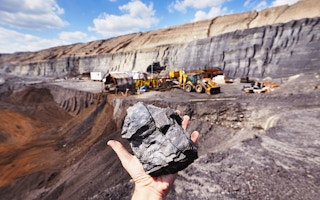The data, from BP’s statistical review of world energy 2016, shows a declining role for coal as oil, gas and renewables all gain ground. Coal is one of the most polluting sources of energy and limiting its use will be key to achieving the aims of the Paris Agreement on climate change.
Indeed, global energy-related CO2 emissions stopped growing last year, BP says, and the record reduction in coal was a key factor. Carbon Brief explores why coal use fell so much last year.
Record coal drop
The reduction in global coal use last year is unprecedented during the 50-year dataset of BP’s statistical review. The 71Mtoe fall is the largest recorded in tonnes, and also in percentage terms.
This striking reduction has been reported by the Financial Times and the Telegraph. Spencer Dale, BP chief economist, called it an “annus horribilis” for coal, the Times adds. But why did it happen?
Only a handful of other years have seen a year-on-year drop in global coal use. Typically, these have followed recessions, such as those in the early 1990s, the 1997 Asian financial crisis and the 2008 global financial crisis. In contrast, the global economy grew an estimated 3 per cent during 2015.
It’s interesting to note that the record fall in coal use came despite falling prices. Global coal prices have roughly halved since 2012, after four straight years of declines. The global coal trade has also cooled, with volumes falling for that past two years.
China and US plummet
The global reduction in coal demand was driven by the US, where it fell by 58Mtoe (12.7 per cent) and China, down 29Mtoe (1.5 per cent). These reductions were only partially offset by rising coal use in India, up 19Mtoe (4.8 per cent).
The EU saw a relatively small 5Mtoe reduction in coal demand, while the rest of the world was flat. Strong, 15 per cent growth in Malaysia, Vietnam and Indonesia was offset by sharp falls elsewhere, particularly a 5 per cent reduction in former Soviet states, struggling with the financial impact of cheap oil.
For the US, a continuing shift towards gas-fired power generation along with growth in renewables, electricity demand in long-term decline and the closure of older, more polluting coal plants is behind the reduction.
With President Obama’s clean power plan on hold, probably until after the US election, this progress is not guaranteed to continue, though US gas prices are likely to remain low as gas output continues to surge.
Meanwhile, in China, economic wobbles, renewables and its air pollution drive have been key factors in reducing coal demand. After renewed economic stimulus this year, China’s coal imports have finally picked up, but this, too, could be temporary.
Despite increases in some countries, Asian coal demand growth appears to be slowing, with question marks hanging over the region’s significant coal expansion plans. For instance, India recently said it does not need any new coal power capacity for the next three years, beyond what is already being built.
Changing places
These annual changes should be viewed in the wider context of overall coal demand, where coal is still the world’s second-largest source of energy and China still accounts for around half the world total.
After two years of accelerating declines, the future path for China’s coal demand will be closely scrutinised. Further declines, or at least a peak in Chinese demand, hold the key to continued reductions in global coal use. They are also a must if China, and the world, are to actually cut CO2 emissions, rather than simply stopping them from increasing.
Also of note is that India overtook the US last year to become the world’s second largest consumer of coal, measured in energy content terms (Mtoe). India has posted steady growth in coal demand for years, though the pace remains far below that achieved by China in the decade from 2002.










